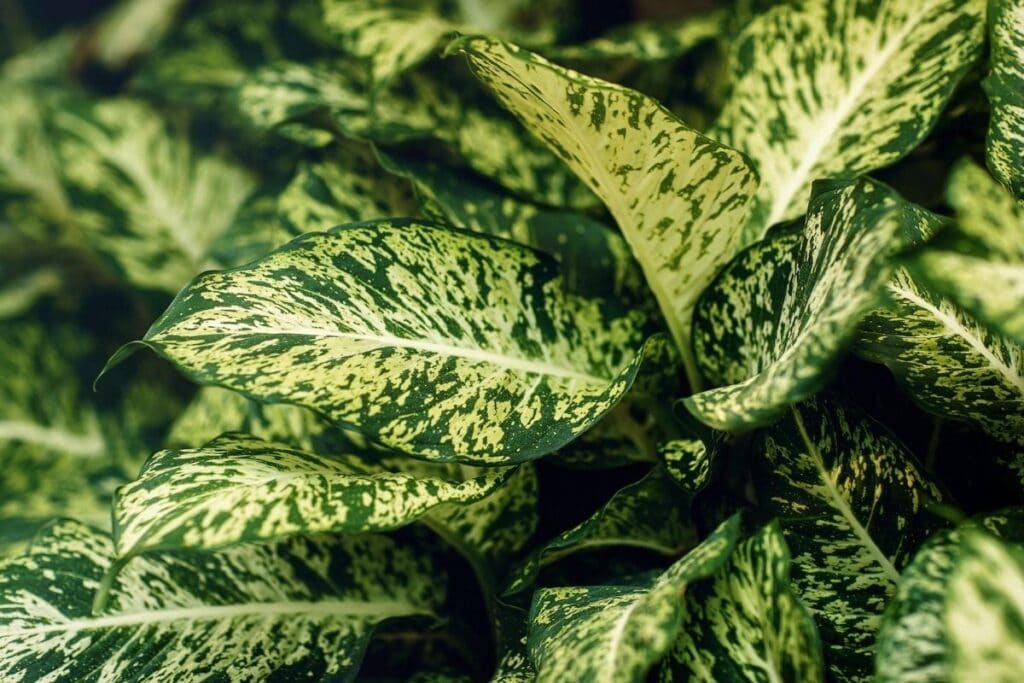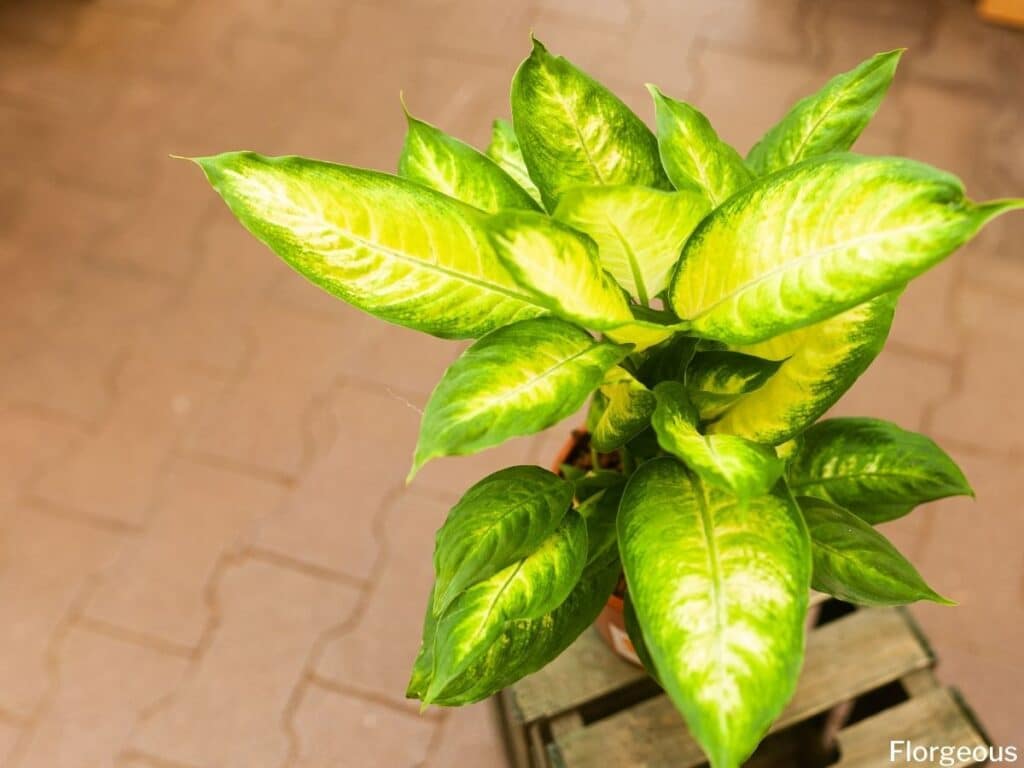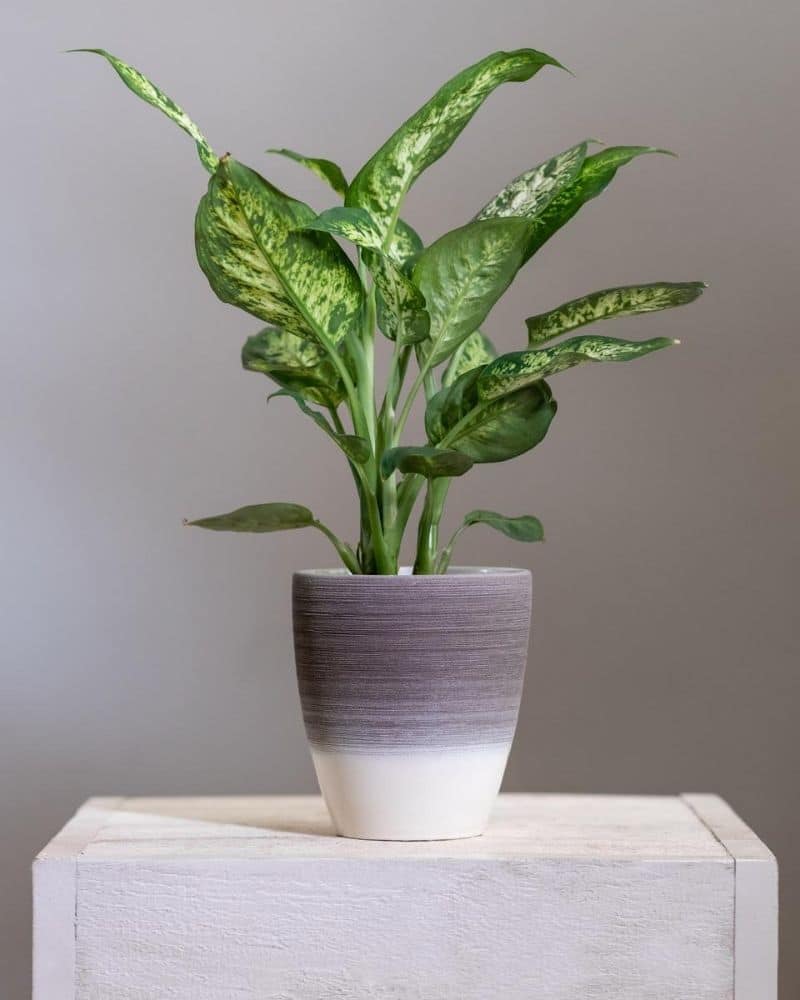Although they come with a bit of danger, Dieffenbachia spp remains one of the popular aroid species used to decorate households.
Their large, showy foliage drowns the fact that it is one of the most dangerous houseplants for humans and animals alike. But with the proper handling and care, the dangers of having Dieffenbachia could be avoided, all while enjoying the most out of this beautiful plant.
Dieffenbachia is a genus under the family Araceae (Aroid family). It is a flowering plant that originated in the tropical forests of South America.
These are evergreen plants, with leaves that are patterned green and white. They grow up to 12 inches tall and sometimes bloom into a pale spathe inflorescence that is rather inconspicuous under the large, showy foliage.
Also known as dumb canes, they are used by the natives in various folkloric medicines and as an ingredient in poison arrows. Nowadays, they are popular plants to adorn both indoor and outdoor spaces with many cultivars and varieties.
Grown mainly for their beautiful foliage, Dieffenbachia is perfect in giving any space a warm, tropical look.
In this post, we’ll walk you through everything you need to know in order to grow dumb cane plants successfully!
Plant Facts
| Scientific name | Dieffenbachia |
| Common names | Dumb cane plants, mother-in-law’s tongue plants |
| Family | Araceae |
| Plant Type | Houseplant |
| Height and Width | 3-10 ft tall, 2-3 feet wide |
| Origin | Central and South America, Caribbean |
| Flower colors | None |
| Foliage color | Green with white flecks and spots |
| Sun Exposure | Filtered sunlight |
| Soil Type & pH | Well-drained, neutral soil |
| Special features | Shade tolerant, toxic sap |

How to Grow Dieffenbachia Plants
If you’re ready to learn how to grow your own dumb cane plants at home, this article will serve as your ultimate guide.
Propagation
Dieffenbachia is easy to propagate through stem cuttings or tip cuttings. When propagating by stem cuttings, choose ones that have at least one lateral bud and cut them into 2” pieces. Stick them in sphagnum moss for faster rooting.
For tip cuttings, just choose from either the terminal bud or the lateral bud of the plant. When propagating Dieffenbachia, make sure to avoid contact of the plant sap with your skin.
You can also propagate by a stump. To do this, cut the top off an older, leggy plant. Put the remainder of the entire plant in fresh potting soil with a bit of rooting hormone. New leaves should sprout from this stump. Once they do, you can remove the older ones.
Soil
Dieffenbachia plants thrive in loose and fertile soil that drains well. A well-draining soil is important to prevent overwatering. Use a combination of perlite and potting soil (1:1), or soil and peat (1:1) for best results.
Pruning
Several dieffenbachia species do not need regular pruning. You only need to remove leaves as they become old and yellow or die back. Other than that, no grooming is needed.
Repotting and Transplanting
The best time to repot your dumb cane plant is just before the growing season begins, so at the end of winter or the beginning of spring. Choose a container that is larger than the existing one, but make sure it’s not too large or your plants’ roots will be swimming in their new home.
Make sure the container has drainage holes and repot in a mixture of vermiculite, peat moss, and loam.

How to Care for Dieffenbachia
Dieffenbachia is not the most hardy of houseplants. It is quite fickle and fussy when it comes to its growth requirements. With the proper care and maintenance, you can keep your Dieffenbachia plants thriving for years.
Water
Dieffenbachia are herbaceous plants with lots of water in their stems. Overwatering can cause the indoor plant to develop leaf yellowing and root/base rot. Pay close attention in watering your Dieffenbachia plants. Water them regularly while allowing the soil to dry before the next watering.
On average, you’ll need to water once every few days (or one to two times per week). The exact amount of watering you’ll need to do will vary depending on the individual pieces, location, soil types, time of year, humidity, and lighting. The plants need more watering in the growing season between March and October.
You may notice that, occasionally, your tropical plant begins to drip water. This isn’t necessarily a sign of overwatering but of transpiration. Check the soil to be sure of whether you need to water or not.

Sunlight
What makes Dieffenbachia a perfect houseplant is the fact that it thrives well under shaded conditions. But that does not mean it doesn’t need light. Place your Dieffenbachia plants in areas where they can receive diffused sunlight or in partially shaded areas.
The best locations for dumb cane plants will be those that are semi-sunny or shaded. It can also be grown under artificial grow lights, but this may cause the coloring of the foliage to be dull.
If you grow your plant outdoors, be sure to provide it with some protection from direct sunlight. Too much sun can burn the leaves.
Temperature and Humidity
Because of their tropical nature, Dieffenbachia plants have specific temperature requirements. These plants are sensitive to low temperatures.
To ensure optimal growth, temperatures should be between 60-75oF (15-23oC). High humidity is also recommended although they can thrive well under normal humidity.
If you live in a warmer climate, you can also grow dumb cane plants outdoors for much of the year. Just make sure you offer some protection against the harsh wind and other elements. You’ll need protection from the cold if temperatures drop beneath 55 degrees Fahrenheit.
Fertilizer
Dieffenbachia are heavy feeders which means they require more nutrients compared to average plants. But sometimes, overfertilizing can cause damage to plants such as leaf tip burn and leaf browning.
To avoid this, use a complete fertilizer with 20-20-20 ratio every 4-6 weeks through the growing season (March-September).
It is important that you don’t fertilize in the winter. This can burn the plants and make it harder for them to recover. That said, you may wish to fertilize when you transplant or repot your plant.
Pest and diseases
The dumb cane plant is not one that is prone to very many pests or diseases. If you encounter issues with your plant, it’s likely due to overwatering. You’ll know overwatering is the culprit if you notice dying leaf tips, curled leaves, or plant rotting. Address your watering mistakes and, if necessary, repot the plant into a fresh container with new, dry soil.
Another issue to watch out for is a specific type of bacteria named Erwinia. This causes leaf joints to rot, with the infection quickly spreading to the rest of the plant (including the stem). Sadly, there’s not much you can do to treat this disease once it’s set in. You’ll need to do some thorough disinfecting to make sure the bacteria doesn’t spread to the rest of your plants.
Anthracnose is another common disease, leading to dark black or brown spots in the leaves and margins. You can prevent this fungal disease by limiting humidity and using a fungicide to stop the spread. A similar fungal disease is Fusarium, which can be prevented and treated in the same way.
As far as pests go, watch out for common indoor pests such as aphids, spider mites, and mealy bugs. When indoor conditions are warm and dry, it creates the ideal environment for these pests to set up shop and begin feeding on your plants.
Dust them off the leaves and inspect your plants weekly for new infestations. You may be able to use an insecticidal spray for more severe infestations.
Common Varieties and Cultivars
If you’re thinking about growing dumb cane plants consider these common dieffenbachia varieties and cultivars.
D. amoena
D. amoena are large varieties of Dieffenbachia that make wonderful floor plants or plants for covered patios. They grow quite tall and have a massive spread.
A common cultivar is ‘Tropic Snow’.
D. seguine
This is the most common species of Dieffenbachia. They are previously known as D. maculata and D. picta. They feature dark green leaves patterned with white stripes on both sides of the midrib. D. seguine is often used as one of the parent plants of many Dieffenbachia cultivars.
- D. seguine “Camille” – “Camille” is one of the most common cultivars of D. seguine. This cultivar grows up to 31 inches tall and features large, oval leaves with a delicate pattern of dark green margin that fades to a creamy white at the center.
- D. seguine “Exotica” – “Exotica” is a tall, showy cultivar of D. seguine. This cultivar features ivory white leaves with green specks, and a narrow green pattern on the margin. They can grow up to 24 inches tall.
D. oerstidii
This is the only variety of Dieffenbachia that has leaves that are almost green all throughout, except for the midrib which is ivory white. The leaves are impressive with their solid matte color. They can grow up to 51 inches in height.
FAQs
How often do you water a Dieffenbachia?
Water dieffenbachia when the top inch of soil feels dry to the touch, typically every 1-2 weeks. Ensure proper drainage to prevent waterlogging, which can lead to root rot.
Does Dieffenbachia need direct sunlight?
Yes, Dieffenbachia prefers bright, indirect light but can tolerate some shade. Avoid placing it in direct sunlight, as it can scorch its leaves.
Does Dieffenbachia clean air?
Yes, Dieffenbachia is known to be an air-purifying plant, capable of removing toxins such as formaldehyde, benzene, and trichloroethylene from indoor air, thus contributing to cleaner air quality.
How do you keep Dieffenbachia from falling over?
To prevent dieffenbachia from falling over, provide sturdy support such as a stake or trellis for taller varieties. Additionally, regularly inspect and prune the plant to maintain a balanced and sturdy growth habit. If necessary, repot the plant into a larger, more stable container to prevent toppling.
Conclusion
If you’re thinking about growing dumb cane plants, there’s one thing you need to know – it can be dangerous.
The plants contain oxalate crystals, called raphides, in all parts of the plant. When ingested, it causes irritation and inflammation of the tongue and throat, resulting in speechlessness and choking. (1), which is why they are also called ‘dumb cane’ or ‘mother-in-law’s tongue’ (2).
Nevertheless, the effects are not life-threatening for humans and animals, with the severe cases resulting in lasting pain for several days (3). Contrary to popular belief, Dieffenbachia is, in fact, not poisonous. It is more of an irritant that irritates the mucous lining of the mouth and throat.
The plant sap also contains raphides and could cause contact dermatitis and could irritate the eyes. So, make sure to handle Dieffenbachia with care when repotting or propagating.
Otherwise, know that the dumb cane plant is an easy, rewarding houseplant to grow – so buy one and get started today!






